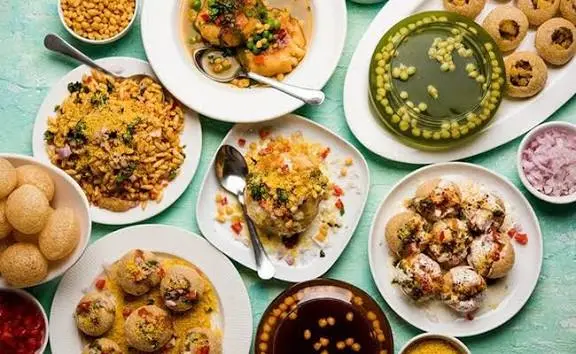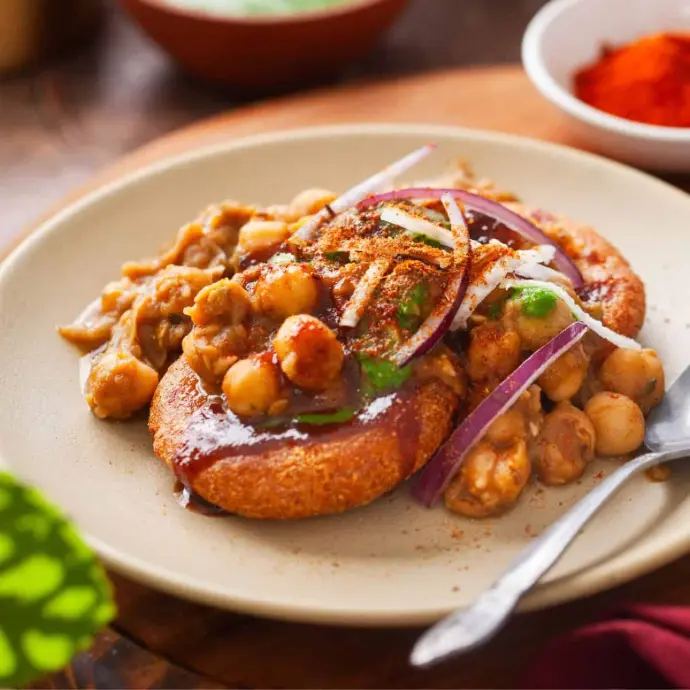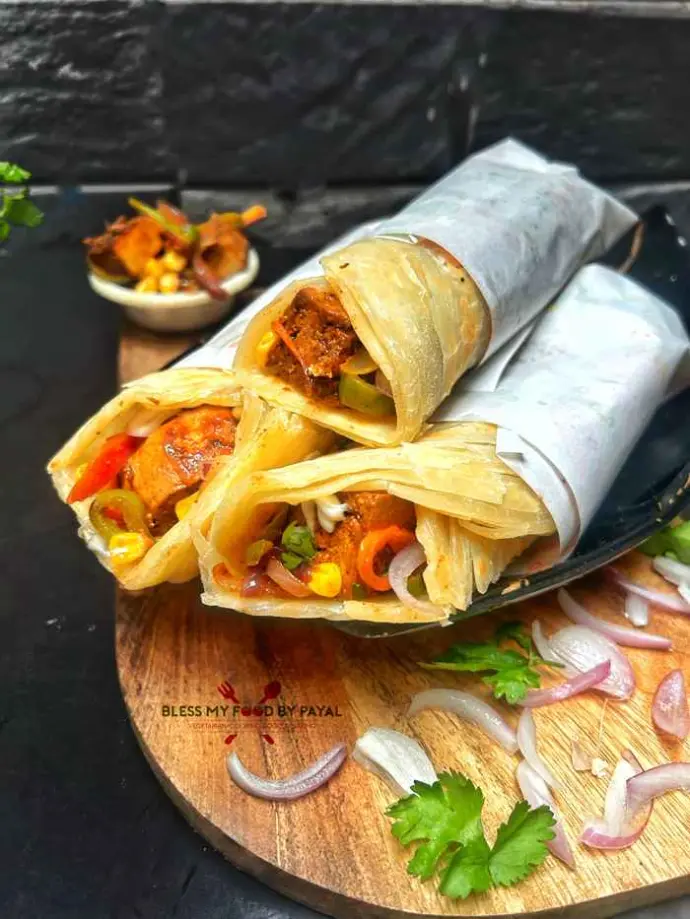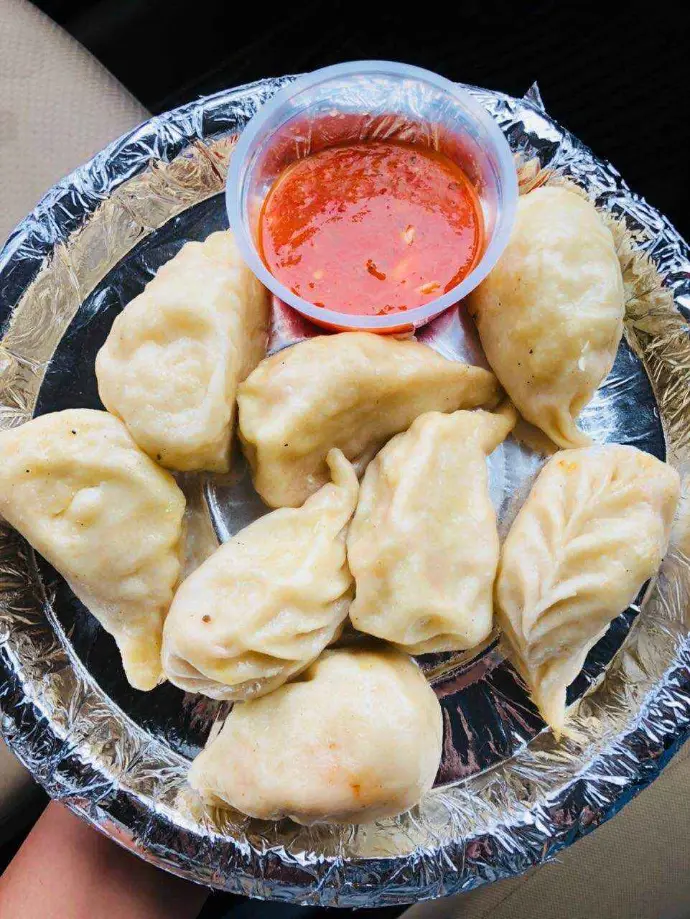Introduction: Why Street Food in Delhi is Special
Delhi’s street food reflects centuries: the Mughal courts, the old bazaars of Shahjahanabad, the intermingling of Punjabi, Kashmiri, Bengali influences, and more modern additions (Chinese, Tibetan, etc.). The streets are alive from early morning till late night with vendors, carts, people eating standing up or perched on curbs, flavours flying through the air — cumin, fried dough, sweet syrups, masalas, smoke from tandoors.
Street food isn’t just about hunger — it’s culture, community, history. Every chaat stall, every kulfi shop tells a story.
Top 10 Street Foods to Try in Delhi
Here’s a list of must-try foods, plus where to get the best and what makes each one special.


1 : Chole Bhature
Delhi and "Chole Bhature" are inseparable. This dish is a breakfast favourite for many Delhiites, though you’ll find people enjoying it at any time of the day. The dish is a combination of spicy, tangy "chickpeas (chole)"cooked in a rich tomato-onion gravy with a strong base of North Indian spices, paired with "bhature"—deep-fried fluffy bread made of refined flour. The bhature is crispy on the outside but soft and airy inside, making it the perfect vessel to scoop up the spicy chole.
What makes Chole Bhature so iconic is not just the taste, but the experience. Alongside, you’ll often get sliced onions, pickles, and sometimes a glass of lassi to balance the spice. For locals, it’s more than just food—it’s comfort, nostalgia, and Sunday brunch all rolled into one.
Some legendary outlets have been serving it for decades, such as "Sita Ram Diwan Chand in Paharganj" , which is almost a pilgrimage spot for Chole Bhature lovers. "Chache Di Hatti in Kamla Nagar" is another hotspot, especially among college students. The aroma of ghee and fried bhature hitting your senses while you wait in queue is enough to make your stomach growl.
If you’re in Delhi, skipping Chole Bhature would mean missing out on a huge slice of its culinary identity. It’s not just food—it’s a celebration of Delhi’s love for bold, hearty flavours.

2 : Stuffed Paranthas " Paranthe "
When it comes to breakfast in Delhi, stuffed parathas are a timeless favourite. These flatbreads are made of wheat flour and generously stuffed with fillings such as potato, paneer, cauliflower, radish, onion, or even sweet stuffings like jaggery and khoya. What makes Delhi’s parathas special is the heavy use of desi ghee, which gives them a rich aroma and crisp-soft texture. Served piping hot with butter, curd, pickle, or even a glass of lassi, parathas are the very definition of comfort food.
The most famous spot for this dish is "Paranthe Wali Gali in Chandni Chowk" , an iconic lane that has been serving parathas since the Mughal era. Shops here experiment with unusual fillings—like rabri, banana, dry fruits, or even green chili parathas—that you won’t find elsewhere.
For Delhiites, parathas aren’t just food; they are part of cultural heritage. Families often sit together for weekend breakfasts with a stack of hot parathas straight from the tawa. If you want to taste Delhi’s soul on a plate, head to Old Delhi and grab a ghee-laden parantha—it will keep you full, warm, and delighted for hours.

3 : Golgappe " ( Pani Puri / Puchka ) "
No discussion about Delhi street food is complete without "golgappe"—small, hollow puris filled with spicy, tangy water and potato or chickpea stuffing. Known as pani puri in Mumbai and puchka in Kolkata, golgappe in Delhi have their own unique flavour. The water, or "pani", comes in varieties—spicy mint, tangy tamarind, sweet jaggery, and sometimes even hing (asafoetida) flavoured.
The joy of eating golgappe lies in the experience: you pop the whole puri into your mouth, and it bursts with an explosion of flavours—crunchy, spicy, sour, and sweet all at once. It’s addictive, and no one stops at just one.
Delhi has countless golgappa vendors, but some of the most popular ones are in "Bengali Market, Connaught Place, and Rajouri Garden" .Locals often debate endlessly over which vendor serves the best golgappe, making it a fun, competitive street food.
For first-timers, remember that Delhi golgappas are spicier than in many other cities—so prepare for watery eyes and wide smiles. They are more than a snack—they’re a cultural ritual, often eaten with friends or family after shopping or evening strolls.

4 : " Aloo Tikki Chaat "
Crispy on the outside, soft and spicy on the inside—that’s "Aloo Tikki Chaat" , one of Delhi’s most loved evening snacks. Made from mashed potatoes mixed with spices and shallow fried into patties, these tikkis are served hot with tangy tamarind chutney, spicy mint chutney, yoghurt, chopped onions, and crunchy sev. The combination of textures and flavours makes every bite irresistible.
What makes Delhi’s aloo tikki unique is the balance—sweet curd, spicy chutneys, crispiness from the tikki, and freshness from coriander. Some vendors even stuff the patties with peas or paneer for extra taste.
One of the most famous places to try this dish is "Natraj Dahi Bhalle Wala in Chandni Chowk " , which has been serving legendary chaats since 1940. You’ll also find great versions in Janpath and Karol Bagh.
Aloo tikki chaat is more than just food—it’s the perfect winter snack. On chilly evenings, the warmth of the tikki combined with cooling yoghurt creates a magical contrast. If you want to taste true Delhi comfort, aloo tikki is a must.

5 : " Delhi Chaat ( Papri Chaat & Variants ) "
Delhi is often called the “Chaat Capital of India.” Chaat isn’t one dish but a whole category of sweet-spicy-tangy snacks, and each type tells a story. The most famous is "Papri Chaat " , which uses crispy fried wafers topped with boiled potatoes, chickpeas, curd, tamarind chutney, mint chutney, pomegranate seeds, and spices like chaat masala. Other popular varieties include "Dahi Bhalla", "Samosa Chaat" , and "Fruit Chaat".
What makes Delhi chaat legendary is its balance of flavours—sweet, sour, salty, spicy, and tangy all in one plate. It’s food that awakens every taste bud. Vendors often prepare it fresh in front of you, layering each ingredient like an artist painting on canvas.
Some of the best places for chaat are *Prabhu Chaat Bhandar near India Gate, Bengali Market, and Chandni Chowk*. Evening time is best, as the atmosphere is lively and the food tastes fresher.
For locals, chaat is not just a snack but a way of socialising—friends gather at stalls after work, families stop by after shopping. Eating chaat in Delhi is less about hunger and more about fun, community, and indulgence.

6 : " Samosa And Kachori "
If there’s one snack that defines street corners in Delhi, it’s the "samosa". A crispy, triangular pastry filled with a spiced potato and pea mixture, deep-fried until golden, and served with tangy tamarind or spicy mint chutney. With every bite, you get that crackling crunch followed by the warmth of the soft, masala-filled centre. In winter, samosas paired with a cup of chai are pure happiness.
Close cousins of the samosa are "kachoris"—round, flaky pastries stuffed with spicy lentil, onion, or potato mixtures. Unlike samosas, kachoris often have a sharper, more masala-heavy flavour, making them perfect for those who love bold spice. They are often served with aloo sabzi or chutneys, creating a filling snack.
Samosas and kachoris aren’t just street snacks in Delhi—they’re part of daily life. Offices, colleges, and families all turn to them during tea breaks or celebrations. Famous places to try them include "Kumar Samose Wala in Moti Nagar, Bangla Sweet House in CP, and Haldiram outlets". But honestly, even small neighbourhood vendors serve lip-smacking versions.
In Delhi, no evening walk is complete without the aroma of frying samosas wafting through the air. Whether it’s a quick bite or a comfort snack, samosas and kachoris are timeless companions for Delhiites.

7 : " kebabs and Grilled Meats "
Delhi’s Mughal past lives on in its "kebabs and grilled meats". Juicy, smoky, and spiced to perfection, kebabs are a must-try for meat lovers. From "seekh kebabs" made with minced meat skewered and grilled, to "shami kebabs" that are soft, melt-in-the-mouth patties, Delhi has it all. You’ll also find galouti kebabs, boti kebabs, and tikkas sizzling on street grills.
What makes Delhi’s kebabs special is the marinade—a blend of yoghurt, ginger-garlic, chilli, and traditional Mughal spices—that gives the meat deep flavour. Cooked on charcoal, kebabs have that irresistible smoky aroma that pulls you towards the stall even from afar.
The most iconic kebab destination is "Karim’s near Jama Masjid" , serving Mughlai delicacies for over a century. Other famous spots include "Qureshi Kebabs in Chandni Chowk and Moinuddin Kebabs in Ballimaran". Even modern food hubs like Dilli Haat or Khan Market have their own versions.
Eating kebabs in Old Delhi is an unforgettable experience—the sizzling skewers, aroma of spices, and bustling atmosphere make it feel like stepping back into history. If you want a true taste of Delhi’s royal past, kebabs are the answer.

8 : " Kathi Rolls and Street Wraps "
Portable, delicious, and loaded with flavour—"Kathi rolls" are Delhi’s answer to on-the-go meals. Originally from Kolkata, these rolls have been embraced by Delhi and given a North Indian twist. They are made by wrapping spiced meat, paneer, or veggies in a paratha or rumali roti, along with onions, sauces, and chutneys.
The beauty of Kathi rolls lies in their versatility. You’ll find chicken tikka rolls, paneer rolls, egg rolls, even fusion fillings like mushroom or soy chunks. The balance of smoky tandoori flavour inside a buttery paratha makes them hard to resist.
Areas like "Connaught Place, Khan Market, and Lajpat Nagar" are famous for their roll joints. Popular chains like "Nizam’s Kathi Kabab" have made them legendary. For students and office-goers, rolls are the ultimate grab-and-go meal that fills the stomach without burning the pocket.
Delhi’s kathi rolls reflect the city’s spirit—quick, flavour-packed, and always evolving. Whether you’re shopping, travelling, or just hungry at midnight, a roll stall will always be nearby to satisfy your cravings.

9 : " Kulfi Faluda And Indian Sweets. "
After all the spicy and savoury snacks, Delhi’s street food trail isn’t complete without a dose of "kulfi and falooda". Kulfi is a traditional frozen dessert, denser than ice cream, made with milk, sugar, saffron, pistachios, and cardamom. Falooda takes it a step further by adding vermicelli, rose syrup, and sweetened milk to the kulfi, making it a rich, indulgent dessert.
Delhi also boasts classics like "jalebi, gulab jamun, and rabri", which are often sold fresh from huge kadais by roadside vendors. These sweets aren’t just desserts—they’re comfort food, celebratory treats, and the perfect end to a street food adventure.
Some must-visit places are "Giani’s in Chandni Chowk, Bengali Market for kulfi falooda, and Old Famous Jalebi Wala" .On hot summer evenings, nothing cools you down like a stick of kulfi in hand, while in winter, jalebis with rabri warm your soul.
For Delhiites, sweets are more than sugar—they’re nostalgia and joy. Every festival, wedding, or even casual outing ends with a sweet treat. If you want the complete Delhi experience, save space for desserts.

10 : " Momos And Indo Chinese Street Food "
Delhi has wholeheartedly adopted Tibetan and Chinese flavours, making "momos" one of the city’s hottest street snacks. These soft dumplings, steamed or fried, are filled with vegetables, chicken, or paneer, and served with fiery red chilli chutney. The combination of delicate dough with spicy filling and hot sauce is addictive.
Beyond momos, Delhi’s Indo-Chinese street food culture offers chowmein, chilli potatoes, spring rolls, and manchurian, all adapted to suit local tastes—extra masala, extra spice, and bold flavours.
Areas like "Lajpat Nagar, Amar Colony, and Dilli Haat" are momo hubs, while almost every marketplace has its favourite Chinese cart. Students especially love momos because they’re affordable, filling, and available everywhere.
What makes Delhi’s momos unique is their fusion—stuffed with Indian spices, served with extra-hot chutneys, and often reinvented as tandoori or gravy momos. They’re not just food; they’re part of Delhi’s evolving street culture, reflecting its openness to new flavours.
If you want to see Delhi’s modern street food identity, momos are the perfect symbol—simple, global, but with a spicy local twist.
Where to Walk & Eat — Foodie Walk Ideas
Old Delhi (Chandni Chowk / Jama Masjid area) — Best for parathas, kebabs, chaat, sweets. The energy here is unmatched. Historic alleys, old-style shops.
Connaught Place / Bengali Market — Cleaner, more accessible, good mix: chaat, golgappas, pav bhaji, sweets.
Kamla Nagar / North Campus — Youthful, many street stalls, especially for breakfast & snacks.
Lajpat Nagar / South Delhi markets — For rolls, momos, modern street food twists.
Tips for Getting the Best Experience
Go when it’s busy. If a vendor has a queue, it’s usually a good sign: turnover means fresher food.
Observe hygiene (reasonably). Street food won’t be restaurant-clean, but look for vendors who have clean hands, clean utensils, fresh ingredients. Avoid water used from open, unclean sources.
Spice levels. If you’re not used to very spicy food, tell them to reduce chili or masala. Delhi vendors are generally open to adjusting.
Eat where locals eat. If the stall is crowded with locals, chances are it’s good.
Explore beyond the obvious. Every alley, market has a hidden gem. Talk to people, ask hotel or local shopkeepers for recommendations.
.
Sample Food Day Itinerary
• Morning: Start with breakfast — maybe parathas in Old Delhi or chole bhature somewhere local.
• Late Morning / Midday: Chaats, golgappas while exploring bazaars.
• Afternoon: Take a break, perhaps sweets + tea.
• Evening: Kebabs or rolls, Indo-Chinese or momos, followed by desserts.
Conclusion
Delhi is one of the few places in the world where street food is not just about quick meals — it’s history, flavour, culture, community. Each bite is layered: spices, texture, tradition. Try to taste slowly, walk slowly, and soak it all in — the smells, the crowds, the sounds. You won’t just fill your belly, you’ll get a taste of what Delhi really is.